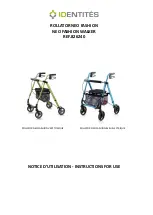
16
Thigh straps
Figure 16a:
Thigh straps are used to make
seated transfers. Choose either narrow
(5”) or wide (7”), depending on the needs
of your client. Additional straps can be
purchased for individual clients.
Pelvic support
Figure 16b:
The pelvic support is used
for sit-to-stand transfers and supported
ambulation. It is attached by hooking
the rings to the color-coded clips of the
body support system. Note that the pelvic
support may fit the patient best when the
straps are crossed.
Hip positioner
Figure 16c:
The hip positioner is used to
encourage optimum pelvic positioning
during gait training. It has an optional pad
for comfort. It is attached by hooking the
back rings onto the black clips of the body
support system and the front rings onto
two of the remaining four clips (including
the yellow ones in the front). Adjust the
four straps for further positioning.
Caster swivel lock
The swivel lock can prevent one or more
of the TRAM’s casters from swiveling.
Locking a front caster improves control
during seated transfers. Locking a rear
caster stabilizes the TRAM when used for
ambulation.
Figure 16d:
To install, insert the prongs of
the swivel lock into the slot found at the
ends of each base leg with the red plunger
pull handle up. The prongs are fully inserted
in the slot when it clicks.
Figure 16e:
To engage, align the caster with
the base leg, and push the plunger all the
way down between the caster’s wheels.
Pull the plunger up to disengage the swivel
lock.
Figure 16d (Low-base swivel lock)
Figure 16e (Standard-base swivel lock)
Figure 16a
Figure 16b
Figure 16c
















































